In urban apartments, as a rule, a small area of rooms and low ceilings are faced. One of the methods to visually increase the height is to fix the curtains not to the top of the window, but as high as possible. For this, cornices are used with fastening to the ceiling.
- Classification of ceiling cornices
- By design
- Based on materials
- Options for selection
- Fastener installation step
- Mounting methods
- On brackets
- With mounting holes
- Hanging mount
- DIY fastening features
- To the concrete ceiling
- To the stretch ceiling
- To plasterboard ceiling
- Wall mount
- How to hang curtains on a ceiling cornice
Classification of ceiling cornices
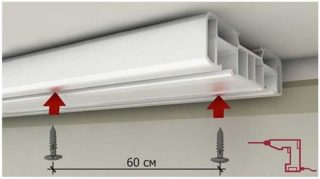
There are adaptations for a variety of reasons:
- mounting method - actually ceiling and wall;
- material;
- type - string, profile, baguette.
Cornices are also classified by purpose. Uniform or simple are used when only 1 curtain is hung or 2 moving towards each other. Multi-row allows you to hang several curtains and curtains and form a complex curtain composition.
By design
The principal difference between the ceiling ones is installation on special brackets to the ceiling. At the same time, there is sufficient space between the overlap and the string so that the curtain on any mounts can move freely.
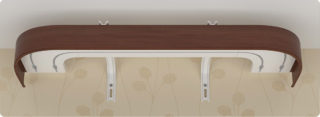
There are many models that differ in appearance and functionality:
- Round - metal tubes or wooden rods. A robust and simple design, reaching a length of up to 4 m. To move the curtain along the bar, rings with clothespins or hooks are used. Round curtain rods are quite heavy, but you can hang the heaviest velvet fabrics on them.
- Baguette is a more complex design. Width no more than 5–10 cm. From the outside, it is a flat decorative element resembling a ceiling plinth. Plastic models are usually modest. Wooden baguette cornices can be really luxurious: they are decorated with carvings, overhead details, gilding.
- Profile - they differ from baguette by a deeper groove and a more modern movement mechanism. The profile version is made of plastic or aluminum.
- Strings - 1 or more stretched strings, nylon or metal. The length of the product does not exceed 2 m. Designed for light curtains;
- lifting is a complex mechanism. The curtains here do not move to the edge, but rise.
Multi-row strong cornices often serve as the basis for hard and soft lambrequins.
Based on materials
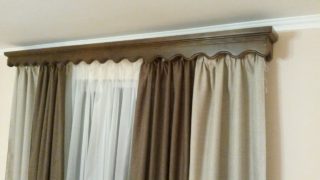
Cornices are made from the following materials:
- Wood - any medium density or even soft species will do for a regular rod. For decorative models, a beautiful and durable tree is chosen: cherry, walnut, oak. If you want to decorate the baguette with carvings, it is better to take softer wood, like alder and linden.
- Metal - brass, aluminum, steel. The first materials are not afraid of corrosion, they serve almost forever. Steel should be protected: covered with a layer of zinc, chromium, painted. Such cornices are extremely durable, strong and can withstand heavy loads.
- Plastic is a simple, cheap, very light material. Ideal for profile products, it is used for baguette and round. Plastic fixtures are designed for a relatively light curtain weight.
It is better to choose polyurethane from plastic models. This material is noticeably stronger and more durable.
Options for selection
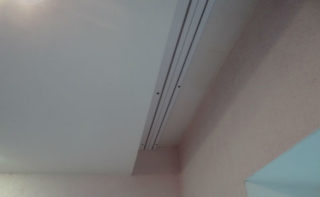
It is reasonable to mount a ceiling cornice if you want to install heavy curtains. For the right choice:
- Determine the weight of all curtains and curtains and select a model with the appropriate indicators.
- The mount is chosen so that it matches the type of curtain and provides easy sliding.
- The position of the cornice is influenced by the design and placement of heating devices and a window sill. It must be set so that the curtains move freely.
- The type of ceiling is important. If a tension is installed in the room, this method of attaching the curtains will have to be taken care of in advance.
Other factors are also taken into account: cost, interior style, color.
Fastener installation step
The ceiling cornice is fixed, taking into account its size and the weight of the curtains:
- PVC profile cornice can have a length of 1.4 to 4 m with a width of 8 to 12 cm. The fixing step is 50-60 cm. Flexible models can have any length. They are attached taking into account the shape: clamps are placed at each bend.
- The length of the baguette version starts from 1.4 m. The maximum reaches 4 m, but it is rare: such a product is very heavy. Typically, the fixing step is 50 cm.
- Round rods are selected by diameter: 16 mm for curtains, 25-28 mm for curtains. The length is not more than 2.5 m. Long cornices are made up of several fragments. Additional fasteners are placed at each joint.
He drills holes for fasteners in plastic baguettes on his own.
Mounting methods
The installation of the cornice on the ceiling is done in different ways. There are several types of fasteners.
On brackets
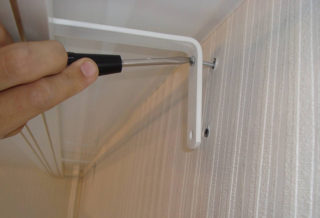
Typical for round curtain rods. Brackets are mounted on the ceiling surface, to which the bar, pipe, strings are then fixed. The work must be done very carefully, since the brackets remain in sight and form part of the curtain composition.
With mounting holes
The cornice is mounted directly on the ceiling. The structure is applied to the surface, a hole is drilled and the product is fixed on self-tapping screws. In reinforced concrete floors, it is better to drill holes in advance. This method is used to install profile and baguette structures.
Hanging mount
It differs from the method for brackets only by the peculiarity of the fasteners - special suspensions. Such installation is more complicated and requires an accurate calculation of the weight of the curtains and curtains.
There is one more installation method - on glue. This is how plastic profile models are mounted, designed for light curtains and curtains.
DIY fastening features
Installation features depend on the type of ceiling.
To the concrete ceiling
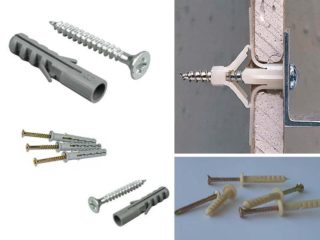
The material is very durable, holds fasteners perfectly and is designed for high loads.
- The attachment point is calculated: 50-70 cm for light curtains and 20-30 cm for heavy ones. The cornice is assembled and the installation sites are marked on it.
- Drills holes in the profile rail for installation. Brackets or suspensions are prepared for other structures.
- Place the tire on the ceiling and shoot holes for screws or dowels through the holes with a puncher.
- They hammer the dowels into the holes, tighten the self-tapping screws. Or they install brackets and fix them with self-tapping screws.
Installation is done carefully so as not to damage the ceiling finish.
To the stretch ceiling

To make a cornice on a film stretch ceiling is somewhat more difficult. The canvas has minimal mechanical strength; at least some brackets cannot be fixed to it.
- Before the installation of the tensioning web, mortgages are installed at the attachment points - a wooden block with a thickness equal to the distance from the stretch ceiling to the base one.
- The thermal rings are fixed on the film. This device does not allow the hole made later to enlarge.
- After installing the film sheet, a hole in the mortgage is shot through the center of the thermal ring.
- They put brackets or fix the profile cornice.
You can fix the curtain or curtain to the stretch ceiling differently. To do this, in front of the window, a beam is attached to the length of the entire wall and the canvas is fixed to it, and not to a real wall. In the cavity that appears, the cornice is fixed in the usual way to the concrete base.
To plasterboard ceiling
The load-bearing capacity of gypsum plasterboard sheets is low. If the rod is light and the curtains will be hung in one row, the curtain rod can be installed directly on the plasterboard ceiling. If the structure is heavy or large, before the erection of the frame on the base floor, a wooden bar is fixed - a mortgage. After facing the frame with plasterboard panels, the baguette is installed on the timber.
There is another, more complicated way - for anchor fasteners.
Wall mount
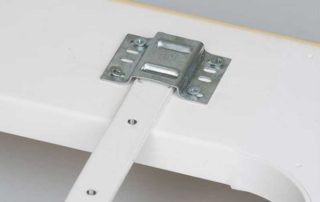
If it is not possible to install the cornice on the ceiling, they resort to the following trick.
- The distance from the attachment point to the wall is calculated so that the curtains and curtains move freely.
- According to this value, metal corners are chosen and holes are shot into them for fasteners - on the wall and for the cornice.
- Fix the corners end-to-end with the wall and ceiling using self-tapping screws or dowels.
- The cornice is mounted on the corners, if it is a profile model, or brackets for a baguette structure are attached.
After installation, plugs, decorative tips, rings are put on the bus or rods.
How to hang curtains on a ceiling cornice
The way of hanging curtains and curtains depends on the type of fasteners. On the bar, the curtains move on rings with clothespins or hooks. If clothespins are used, the fabric is simply secured evenly along its entire length. If there are hooks, first a drawstring is made on the curtain or a special durable tape is sewn to the top. Hooks or clothespins are attached to it.
In profile products, the curtain moves on the sliders along the guide. The runners are supplied with hooks, so the curtain also needs to be hemmed.
The curtains are hung in two ways. You can first attach hooks or clothespins to the fabric, and then insert them one by one into the groove. You can do the opposite: first insert all the hook runners into the groove, and then hang the canvas on them. If the curtain is heavy, the second method is not very convenient.
In terms of functions, the ceiling cornice does not differ from the wall cornice. However, in the interior, curtains attached directly to the ceiling visually increase the height of the room.








